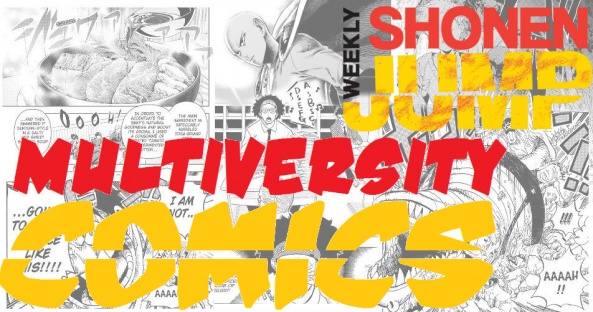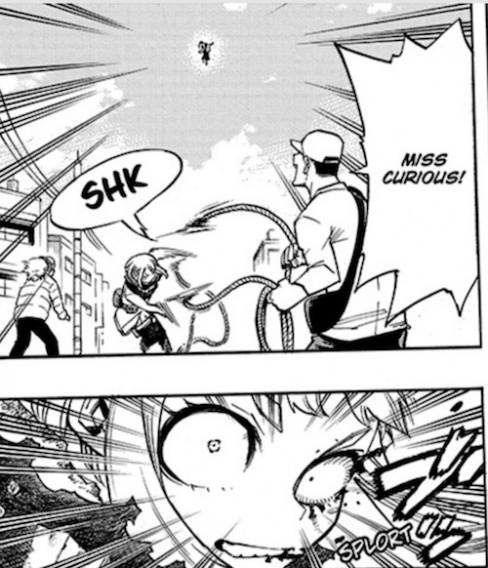
Welcome to This Week in Shonen Jump, our weekly check in on Viz’s various Shonen Jump series. Viz has recently changed their release format, but our format will mostly remain the same. We will still review the newest chapters of two titles a week, now with even more options at our disposal. The big change for our readers is that, even without a Shonen Jump subscription, you can read these most recent chapters for free at Viz.com or using their app.
This week, Ken and Vince check in on “My Hero Academia” and “The Last Saiyuki.” If you have thoughts on these or any other current Shonen Jump titles, please let us know in the comments!

My Hero Academia Ch. 226
Written & Illustrated by Kohei Horikoshi
Reviewed by Ken Godberson III
When it comes to villains, sometimes there are big reasons for why they are the way there are. Perhaps it is the result of trauma. Sometimes it is just from massive amounts of avarice or sheer envy of others.
And sometimes, there really is no reason. To the villain, this is their normal.
“My Hero Academia” Chapter 226 gives us the most brief of insights in to the background and thought process behind the League of Villains member Himiko Toga. In her fight against Chitose Kizuki, the reporter tries to understand Toga and what led her to be the way she is. The resulting factor behind Toga’s world perspective is simultaneously simple and complicated: Blood and Admiration. Toga doesn’t see her drinking people’s blood as some cruelty, but as her way to display affection for people and creatures. Through the briefest of flashbacks, we see Toga trying to display this type of “affection” on childhood friends or little birds. It’s a desire to care for and wanting to be like people like Ochako and Izuku, taken in a horrifying way.
The looks into Toga’s past are brief, but Horikoshi’s artwork does a lot to convey messages through it. Toga’s expressions range from innocent, childish glee to the creepily blissful with her ingesting blood. In the present, Toga’s transformations tend to be more on the sadistic side, but for a brief moment -with her powers evolving- Toga actually looks at peace in her transforming as she takes on Kizuki and her cohorts.
If you were to look at it on basics, this background to Toga could be misconstrued as “She’s Evil Because.” However, Horikoshi does present us with a nice bit of a twist to it and her motivations provide a unique area when comparing with her other League cohorts like Tomura and Dabi. The look behind Toga’s “mask” were brief but it is enough to bring a great deal of complexity to what had been perceived as a shallow character.
Final Verdict: 7.0- A method of “less is more” combined with great art provided an interesting look into a type of “villain.”

The Last Saiyuki – Chapter 9: The Doorway to Summer
Written and illustrated by Daijiro Nonoue
Review by Vince J Ostrowski
‘The Doorway to Summer’ begins by both kicking open the door to a wider scope for “The Last Saiyuki” as a series, but then immediately whisks our hero away to take a more intimate exploration of the demon-hunting challenge that lies before him. But first, a primer: “The Last Saiyuki” refers to an ancient connection the characters have to The Chinese story “Journey to the West.” Now, lots of manga have used “Journey to the West” for inspiration (“Dragon Ball” being the most famous example, by far), but the way this series employs the inspiration adds a wrinkle to the legend that I’m not sure I’ve seen before. I’ve seen direct adaptations, and manga that twist the essential elements of the story into something tangential, but the brilliant thing that “The Last Saiyuki” does is offer the original tale as something like a direct centuries-old prequel to this series’s modern concerns. It really has nothing directly to do with the original story itself. Over the course of the series so far, manga-ka Daijiro Nonoue has woven connections between the principle characters of the story to direct, literal elements of “Journey to the West”, to the point where some of the characters we’re reading about are direct descendants to the protagonists of that ancient tale. It probably helps to know what “Journey to the West” is generally about, and to recognize some of the character names (which you will also recognize from the aforementioned “Dragon Ball”), but trust that it’s really not important in getting emotionally invested into this story and its characters. Actually, it’s quite remarkable how engrossing chapter 9 can be, if you allowed yourself to be swept up in the co-dependent relationship between the de facto step-siblings at the center of the story.
Continued belowAs I said, the chapter opens with Ryu-Nosuke lying in a catatonic state while a group of eclectic new characters stand above him asking mysterious questions. Where are they from? We’re not quite sure, but one of them uses the term “headquarters” so they appear to be from some organization that has a keen interest in the secrets Ryu and his sister, Koharu, are harboring. Up until now, “The Last Saiyuki” has been a story of a young boy growing as a person and learning to take care of an adoptive sister of sorts, whose chief difficulty is trying to quarantine the potential to unleash all the fears in the world manifested as demonic beings. It’s been an intimate, heartfelt affair of a selfish boy slowly learning to see the bigger picture and feeling shame about that selfishness. Just when chapter 9 feels like it’s going to pile on a lot more challenges and lore for these characters, it instead takes a pause to consider whether Ryu is up to the challenge.
In his deep slumber, he is confronted with “Kei” a manifestation of Koharu’s prior life. She pokes into his psyche a bit, they play a game of Connect Five (something right out of “The Seventh Seal”), they talk philosophy, and ultimately she makes him an offer that would allow him to leave the dream and leave the demon-busting challenge ahead of him completely behind. Sure, it probably wouldn’t go well for anyone if he did that, but the offer is on the table. His decision whether to take the offer or not does a great job at pulling in a lot of the elements of his character that the previous 8 chapters revealed to us. That’s a lot of character credibly established in a short amount of time.
And unfortunately that basically brings the chapter to a close, without my getting to highlight perhaps the strongest aspect of this series next to its emotional rigor: the art. Chapter 9 is a handsomely rendered chapter of a manga, but most other chapters of this book have featured at least one short conflict that really makes the book shine. Fears manifest as impossible creatures that are frightful and quite disgusting, at times. These sequences normally pop due to some extra attention to detail and some heavy shading that give the creatures an almost three-dimensional effect. It’s almost like they’re coming to haunt the characters out of some other book. This chapter doesn’t showcase any of that, but settling for some clearly rendered emotion certainly isn’t really a bad thing, it just isn’t as breathtaking as this series can be. Regardless, thanks to the keen attention paid to the emotional investment of the reader, “The Last Saiyuki” is quickly becoming one of the strongest new offerings Shonen Jump has to offer.
Final Verdict: 7.5 – a ponderous chapter of “The Last Saiyuki” definitely deepens the lore of the series in some interested ways for those of us who are invested, but doesn’t showcase all the great things the series has to offer.






